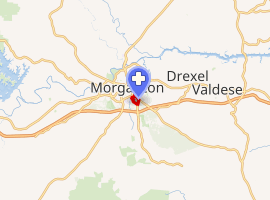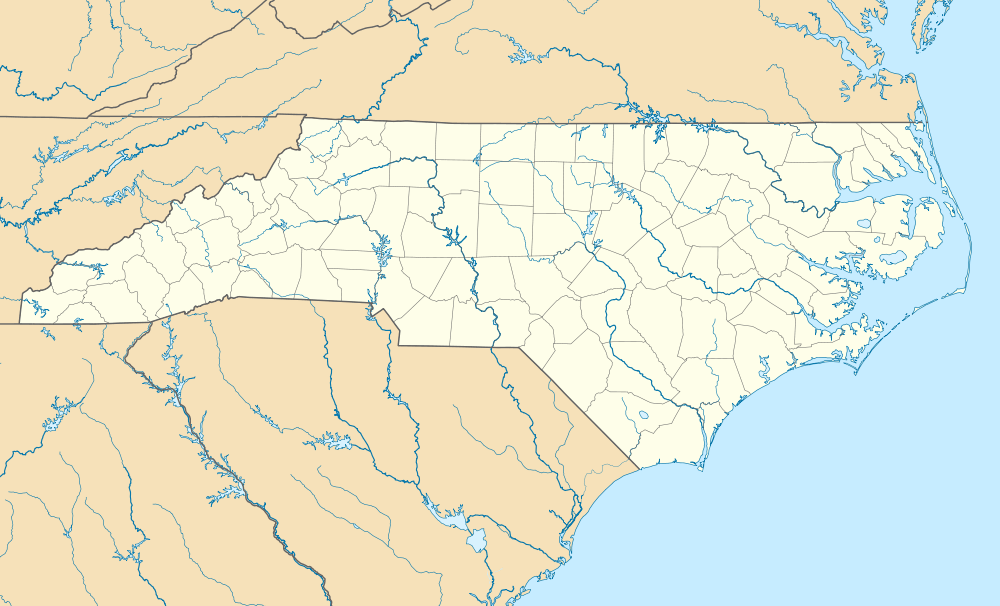Broughton Hospital
Broughton Hospital is a psychiatric hospital located in Morganton, North Carolina. It is administered by North Carolina Department of Health and Human Services Division of Mental Health, Developmental Disabilities and Substance Abuse Services.
| Broughton Hospital | |
|---|---|
| North Carolina Department of Health and Human Services | |
 Broughton Hospital: Avery Building | |

| |
| Geography | |
| Location | Morganton, North Carolina, United States |
| Coordinates | 35.731316°N 81.6729°W |
| Organization | |
| Type | Specialist |
| Services | |
| Standards | Centers of Medicare and Medicaid Management Services (CMS) |
| Beds | 278[1] |
| Speciality | Psychiatric |
| History | |
| Opened | March 29, 1883 |
| Links | |
| Website | www |
| Lists | Hospitals in North Carolina |
| Other links | |
Western North Carolina Insane Asylum | |
  | |
| Location | Off NC 18, Morganton, North Carolina |
| Area | 9 acres (3.6 ha) |
| Built | 1877 |
| Architect | Sloan, Samuel |
| MPS | Morganton MRA (AD) |
| NRHP reference No. | 77000996[2] |
| Added to NRHP | October 5, 1977 |
Broughton Hospital Historic District | |
  | |
| Location | Roughly bounded by Broughton Hospital campus, NC 18, Bickett St., & Enola Rd., Morganton, North Carolina |
| Area | 337 acres (136 ha) |
| Built | 1878 |
| Architect | Sloan, Samuel; Et al. |
| Architectural style | Colonial Revival, Art Deco |
| MPS | Morganton MRA |
| NRHP reference No. | 87001918[2] |
| Added to NRHP | November 9, 1987 |
History
In 1850, influential mental health activist Dorothea Dix petitioned the North Carolina General Assembly to support and build a psychiatric hospital to treat the insane. Within 25 years the General Assembly determined that one hospital was insufficient to care for the population of people afflicted with mental illness. In 1875, the State provided $75,000 for the establishment of a second psychiatric hospital. Built in Morganton on 283 acres (115 ha) of land, Western Carolina Insane Asylum, opened on March 29, 1883. The asylum admitted physician Dr. Red Pepper as its first patient. By 1884 its first director, Dr. Patrick Livingston Murphy, reported to the General Assembly that more space was needed. In 1885 and 1886 two new wings were opened, expanding the hospital's bed space to over 500 patients.
In 1890 the hospital's name was changed to State Hospital at Morganton, a name it kept until 1959. Patients were used to construct roads on the property, and establish and maintain the gardens and grounds. By 1893 the hospital's holdings would encompass over 300 acres (120 ha). During the early 1900s the hospital expanded greatly. Using the colony system, a farm area was established with a dairy, vineyard and greenhouses, all staffed by patients of varying degrees of functionality. The hospital was nearly self-sufficient. Additional expansions and land holdings would take place until just after World War I when public attitudes about mental health patients changed dramatically. The hospital, like many others of this time period, was neglected and suffered during the state and national financial problems of the Great Depression.
During the 1920s, the patient-to-physician ratio was 300-to-1; by the 1930s this was almost 500-to-1. Hours for attendants and nurses were intensive, and time off was sparse. Attendants usually slept in the same wards with patients until further expansion during the 1940s. By that time, the hospital's census topped 3,500 patients. In 1959, State Hospital at Morganton became Broughton Hospital, named after World War II Governor J. Melville Broughton.
The 1960s brought many changes to Broughton: educational programs were established, religious services were incorporated, and the hospital continued to expand (including through affiliated local community health centers). This was part of an effort to de-institutionalize the mentally ill and treat more in local settings. During the 1970s Broughton underwent changes in its housing procedures. Up to that time, its population had been drawn geographically, meaning that patients were being housed according to where they were from, rather than by age or disability. On March 28, 1973, Broughton Hospital received its first survey by the Joint Commission on Accreditation of Healthcare Organizations (JCAHO), and the hospital received a one-year accreditation.
The Broughton Hospital Main Building was designed by architect Samuel Sloan and built in 1877. It was listed on the National Register of Historic Places in 1977 as the Western North Carolina Insane Asylum. The Broughton Hospital Historic District was listed on the National Register of Historic Places in 1987 and encompasses 60 contributing buildings and one contributing site.[2][3][4]
The period from the 1980s through 1990s was especially difficult for Broughton. Facing increased costs and increased oversight from various organizations, Broughton encountered severe budget problems. In December 1992, the Broughton Hospital Foundation was formed. Its goal was to enhance the lives of the patients at Broughton Hospital through donations, endowments, activities, etc.
Today Broughton serves approximately 800 patients per year and employs approximately 1200 staff members, with a $98 million annual operating budget. In 2011, Broughton began hiring temporary and contract staff to help control overhead costs. Broughton completed a new facility in 2017 that houses the hospital departments and patient divisions under one roof, on the existing grounds. The main building is now preserved as a historical landmark that is used as office space.
References
- "Data on Broughton Psychiatric Hospital". NC Division of State Operated Healthcare Facilities. NC Department of Health and Human Services. June 4, 2013. Archived from the original on June 7, 2013.
- "National Register Information System". National Register of Historic Places. National Park Service. July 9, 2010.
- C. Greer Suttlemyre and Jim Sumner (n.d.). "Western North Carolina Insane Asylum" (pdf). National Register of Historic Places - Nomination and Inventory. North Carolina State Historic Preservation Office. Retrieved 2014-08-01.
- Suzanne Pickens Wylie (July 1986). "Jonesboro Historic District" (pdf). National Register of Historic Places - Nomination and Inventory. North Carolina State Historic Preservation Office. Retrieved 2014-08-01.
External links

- Official website
- North Carolina Health and Human Services History of Broughton Hospital
- Rootsweb entry
.jpg)

